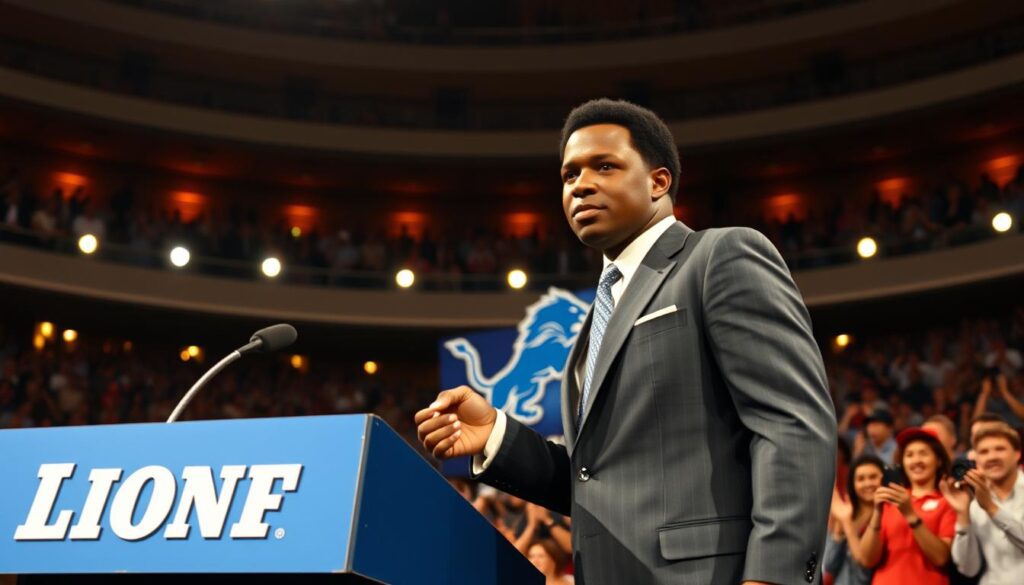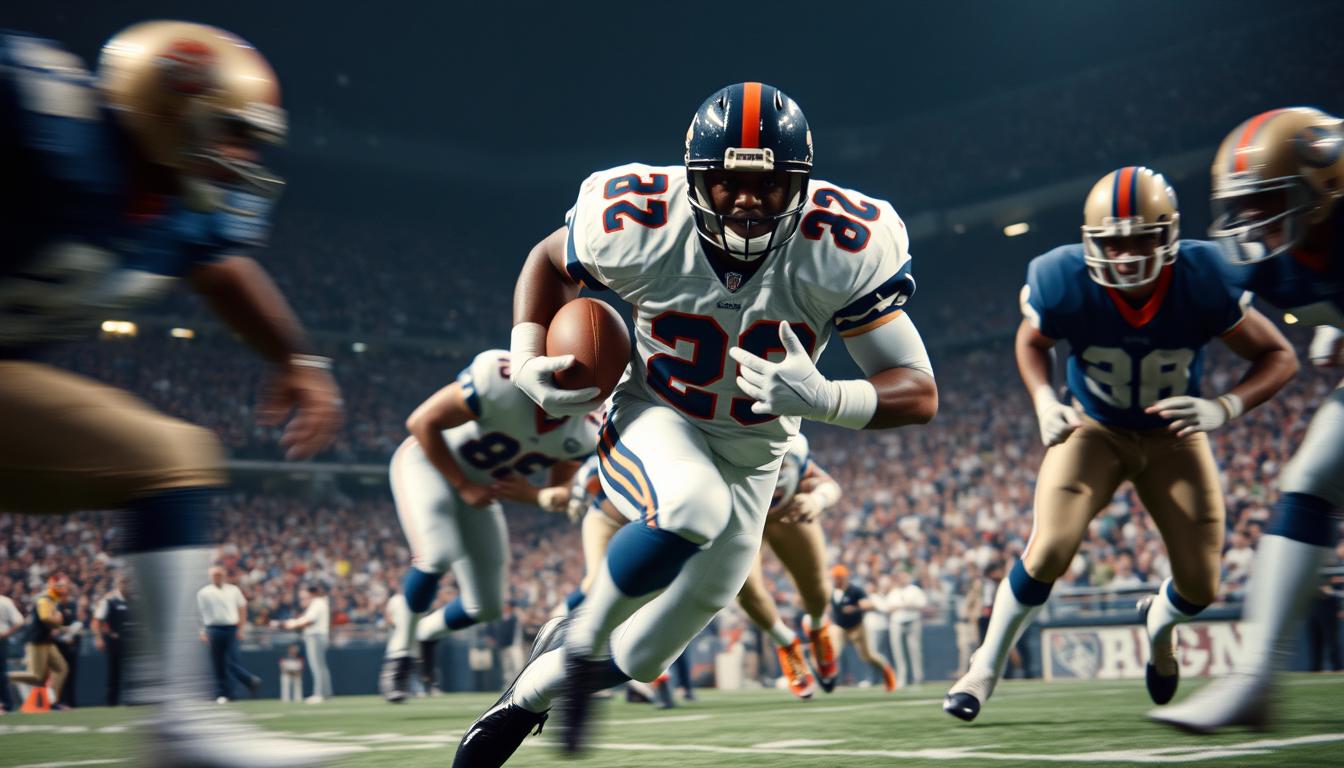Imagine a player so elusive that defenders literally grabbed at air trying to tackle him. During his 10-year career, Barry Sanders averaged over 1,500 rushing yards per season—a feat unmatched in NFL history. His ability to turn broken plays into highlight-reel moments left fans breathless and opponents baffled.
Standing just 5’8” and weighing 203 pounds, the Detroit Lions legend defied expectations in pro football. While others relied on brute strength, Sanders mastered quick cuts and spins that made him nearly impossible to pin down. He led the league in rushing yards four times, proving size isn’t everything on the gridiron.
What truly set him apart was his consistency. In every game, you’d see flashes of genius—sudden direction changes or gravity-defying leaps. By the time he retired in 1998, he’d racked up 15,269 career rushing yards. His induction into the Pro Football Hall of Fame in 2004 cemented his status as one of the sport’s all-time greats.
Key Takeaways
- Averaged 1,500+ rushing yards per season despite a shorter career span
- Revolutionized running back techniques with unmatched agility and creativity
- Earned four NFL rushing titles and 10 Pro Bowl selections
- Retired as the Lions’ all-time leading rusher before Hall of Fame induction
- Proved smaller athletes could dominate in pro football through skill and vision
Barry Sanders: Early Life and High School Beginnings
Long before stadiums roared his name, the NFL legend learned perseverance under the Kansas sun. Born July 16, 1968, in Wichita, Barry Sanders grew up as the seventh of eleven children in a family where hard work wasn’t optional—it was survival.
Family Background and Wichita Roots
His father William balanced roofing and carpentry jobs, while mother Shirley managed their bustling household. Young Barry and his brothers spent summers hauling shingles and sweating through roofing projects. These grueling days forged resilience that later translated to fourth-quarter comebacks on the field.
Early Football and Basketball Experiences
At Wichita North High School, coaches initially parked him at defensive back. Why? His older brother Byron already dominated the running back spot. But when Barry finally got his chance, nobody could ignore his explosive cuts—even during basketball games where he played guard.
Beyond football, he sharpened reflexes through baseball and table tennis. These diverse sports shaped the agility that would later leave NFL defenders grasping at air. Though undersized, his high school years proved greatness starts long before the spotlight hits.
College Career at Oklahoma State
Picture a future Hall of Famer waiting patiently behind another NFL-bound star. That’s exactly how the Oklahoma State legend began his journey in Stillwater. Despite receiving just four scholarship offers, the Wichita native bet on himself by joining the Cowboys program in 1986.
Backup Role and Rise to Starter
For two seasons, Sanders played second fiddle to Thurman Thomas—a future Buffalo Bills superstar. But this apprenticeship proved golden. He studied film religiously and dominated special teams, leading the nation with 31.6 yards per kick return in 1987.
When Thomas graduated, the spotlight finally found its mark. Coaches unleashed #21 as the primary back in 1988, and college football would never be the same. His first start? A casual 222-yard, two-touchdown warmup against Miami (OH).
Heisman Trophy and Record-Breaking Season
What followed was pure magic. In just 11 games, Sanders played like a video game character set to rookie mode:
- 2,628 rushing yards (238.9 per game)
- 37 rushing touchdowns
- 39 total scores including returns
The pinnacle came during a Tokyo bowl game when satellite feeds brought Heisman Trophy news across the Pacific. With 86% of first-place votes, the Oklahoma State phenom claimed college football’s highest honor—then immediately thanked his blockers during the acceptance speech.
Key NCAA Records and College Achievements
College football has seen many stars, but one 1988 season rewrote the record books. The Oklahoma State phenom didn’t just break marks—he shattered them with video-game numbers that still baffle analysts today.
NCAA FBS Records That Still Stand
Let’s start with the jaw-dropper: 2,628 rushing yards in a single season. That’s like running from New York City to Miami—and nobody’s come within 300 miles since. His 37 touchdowns that year? More than 85% of FBS teams scored in 2022.
Consistency separated him from peers. He scored 2+ touchdowns in 13 straight games—a full college football calendar. Four different opponents watched him rack up 300+ yards, including a 332-yard demolition of Texas Tech.
The pace? Imagine averaging 238.9 yards every Saturday. That’s better than most NFL running backs manage in their best games. His five-game stretch of 1,472 yards remains untouched—modern offenses spread the ball too much to replicate this dominance.
Why do these marks endure? Rule changes favor passing, and coaches limit carries to protect players. Sanders’ 1988 campaign stands as a time capsule—proof that one electrifying talent can redefine what’s possible in college football.
1989 NFL Draft and Contract Milestones
What happens when NCAA probation becomes a star’s golden ticket? The 1989 NFL Draft featured one of football’s most fascinating rule exceptions. Though underclassmen rarely entered the pros then, Oklahoma State’s NCAA sanctions created an unlikely path for their junior phenom.

Draft Journey and Entry into the NFL
After the NCAA placed Oklahoma State on probation in January 1989, Commissioner Pete Rozelle made a rare move. He allowed the 20-year-old running back to enter the 1989 NFL Draft early—a decision that changed two franchises forever.
The Detroit Lions grabbed their future legend third overall, passing on higher-profile prospects. Their $9.5 million contract showed immense faith in an unproven rookie. Key details:
- $2.1 million signing bonus (largest for a RB at the time)
- Five-year commitment despite salary cap concerns
- 10% bonus donation to Wichita’s Paradise Baptist Church
This draft-day gamble paid historic dividends. While other picks faded, the Lions secured a generational talent who’d redefine their franchise. That $210,000 church gift? Just the first display of humility from a player who valued community as much as touchdowns.
The 1989 NFL Draft proved rules can bend for extraordinary talent. Detroit’s bold move gave football fans a decade of electrifying runs—and reminded teams that character matters as much as athleticism.
Rookie Season Highlights with the Detroit Lions
When the Detroit Lions unleashed their new weapon in 1989, nobody predicted how quickly he’d rewrite the playbook. His NFL debut against the Phoenix Cardinals showed flashes of brilliance—71 rushing yards and a touchdown on just nine carries. Though the Lions lost 16-13, fans instantly recognized they were witnessing something special.
The rookie didn’t just fill a roster spot—he dominated. Starting 13 games, he bulldozed defenses for 1,470 yards and 14 touchdowns. These numbers weren’t just good for a newcomer; they shattered the Detroit Lions’ existing rushing records held by Billy Sims since 1980.
Immediate Impact and Rookie Accolades
What makes a legendary debut season? Consider these achievements:
| Statistic | 1989 Rookie | Previous Record | Difference |
|---|---|---|---|
| Rushing Yards | 1,470 | 1,437 (Sims, 1981) | +33 |
| Touchdowns | 14 | 13 (Sims, 1981) | +1 |
| All-Pro Honors | 1st Team | None (Rookies) | N/A |
By December, the 1989 Detroit roster boasted the NFL Offensive Rookie of the Year. Voters didn’t hesitate—his blend of agility and raw power earned Pro Bowl selection and first-team All-Pro status. Most players spend years chasing these honors; he claimed them before his first NFL offseason.
This explosive start set the stage for a decade of jaw-dropping performances. From breaking tackles to rewriting record books, the Detroit Lions had found their franchise cornerstone—and the league its newest superstar.
Dominating the NFL: Barry Sanders’ Career Statistics
Numbers tell the story of an athlete who treated defenses like math problems needing solutions. With 15,269 career rushing yards and a Pro Bowl nod every season, this Detroit icon rewrote what we expect from NFL running backs.
Yardage Machine
Imagine gaining five yards every time you touched the ball—for a decade. That’s exactly what happened across 3,062 rushing attempts. The 5.0 per-carry average stacks higher than most Hall of Famers, including Walter Payton and Emmitt Smith.
| Stat | Total | Per Game |
|---|---|---|
| Rushing Yards | 15,269 | 99.8 |
| Touchdowns | 99 | 0.65 |
| Attempts | 3,062 | 19.9 |
Four rushing titles (1990, 1994, 1996, 1997) show sustained dominance. You’d need 1,527 yards annually for 10 years to match these totals—a feat no active player approaches today.
Trophy Case Overflow
Every season brought new hardware. Ten straight Pro Bowl invites? Check. Six First-Team All-Pro selections? Done. The 1997 MVP season capped it off, featuring 2,053 total yards and 14 touchdowns.
Consider these unmatched achievements:
- Only player with 1,300+ rushing yards in first 10 seasons
- Two-time NFL Offensive Player of the Year (1994, 1997)
- Four Second-Team All-Pro honors during “down” years
What’s most impressive? Retiring at 31 with gas still in the tank. Those 15,269 rushing yards could’ve easily topped 20,000 with a few more campaigns.
Memorable Games and Key Performances
Certain games etch themselves into football history like lightning strikes—brief, brilliant, and unforgettable. Barry Sanders delivered these electric moments regularly, turning ordinary Sundays into career-defining showcases.
Regular Season Standout Moments
November 24, 1991, revealed Sanders at his most powerful. After Lions lineman Mike Utley suffered a career-ending injury, #20 honored his teammate with 220 rushing yards and four touchdowns against Minnesota. His postgame “thumbs up” to Utley became an iconic gesture of resilience.
Three other games showcased his versatility:
- A 176-yard, two-TD masterpiece vs. the Raiders (1990)
- Three touchdowns in his rookie finale against Atlanta (1989)
- 135 receiving yards paired with 90 rushing yards vs. Kansas City
Critical Postseason Contributions
Though team success eluded Detroit, Sanders still shined when stakes were highest. His 169-yard playoff performance against Green Bay (1994) included a 47-yard scoring dash—proof he elevated his game under pressure.
These moments didn’t just fill stat sheets. They created lasting memories for fans who witnessed a rare blend of artistry and athleticism in every regular season battle.

